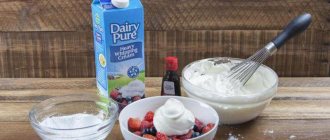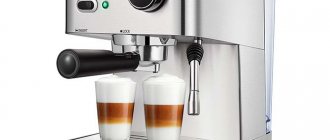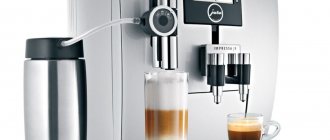Coffee Fredo - what is it?
Fredo is a popular drink in Italy and Greece. It can be prepared even at home, without using a coffee machine or other devices. There are many variations of the recipe, but traditionally 4 main ingredients are used:
- Coffee, espresso mixture;
- Milk;
- Crushed ice;
- Syrup for coffee.
Fredo coffee is most similar to iced coffee, but without ice cubes and has a smaller volume. This is a drink with a rich taste, which is also an excellent digestif, that is, it has a positive effect on digestion, and is especially recommended to drink after a hearty lunch. Iced coffee is more invigorating than hot espresso.
Selection of ingredients
To prepare any coffee drinks in countries located near the Adriatic and Mediterranean Seas, only fresh beans are used, ground immediately before brewing. This is necessary to preserve the aroma of the coffee. If you add soluble granules, you need to buy expensive brands, otherwise the cocktail will turn out tasteless and without aroma.
Milk or cream should be full fat. First, to get foam, low-fat milk additives do not whip well.
A popular ingredient is caramel syrup, although it is often replaced with other toppings, such as fruit or berry liqueur. However, you need to know that milk curdles when exposed to acids, so it is cooled very much before mixing. Fruit sweet and sour syrups are also cooling.
To make delicious Fredo coffee you need a coffee machine, but at home a Turk or even a small saucepan will do. The main thing is that the tea leaves do not boil; it is necessary to bring it to a boil 2–3 times. After this, it is cooled and filtered - grounds are not needed in the drink.
Video: Greek iced coffee
Depending on the fat content of the milk, cream or topping, Freddo can be very high in calories, especially if you sprinkle it with chocolate - up to 150 kcal. At home, you can make a low-fat cocktail and use low-calorie additives.
Fredo coffee recipe
Beans: Use any espresso blend. If it is 100% Arabica, let it be medium roasted; if the roast is strong, it is better to choose a blend with the addition of 20-30% Robusta, which will increase the caffeine content.
- Brazilian Arabica is sweetish and gives body to the drink.
- African Arabica – with a slight sourness, wine and berry flavor.
- Arabica from Central America is slightly sour, with notes of citrus.
- Indonesian Arabica is more piquant and makes the taste of coffee more interesting.
Water: it is better to take purified water, it better reveals the taste of coffee, makes it bright and full.
Milk: optimal fat content 1.5 – 1.8%;
Ice: It is advisable to crush it in a blender immediately before cooking, although if you don’t have a blender, ice cubes will do.
Syrup: caramel syrup is standard, chocolate or vanilla is acceptable, fruit syrup is undesirable, as the milk may curdle.
Brew double espresso in a Turk or any type of coffee machine. If you cook in a Turk, you will need to strain it so that you get 60 milliliters. Pour the espresso into a shaker or similar lidded container, add 50-70 ml milk, 15 ml syrup and 4 crushed ice cubes. Shake several times to create foam.
Tip: If you don’t have a blender, shake the coffee with ice cubes, or put the cubes in a glass and pour the shaken mixture of coffee, milk and syrup over it.
You can add sugar, cinnamon, chocolate chips, whipped cream or whipped milk on top. With whipped milk foam you get a Fredo cappuccino.
The cocktail can also be alcoholic if you add a teaspoon of liqueur.
Preparation technology for the main varieties
There are many variations of the drink, but they are all based on 2 main subtypes - espresso and cappuccino. In the first case, you get cold coffee with syrup, in the second, whipped milk is added. Basic recipes can be modified by adding additional ingredients.
Most often, a Fredo coffee recipe contains the following components:
- espresso;
- milk;
- syrup;
- ice crumbs.
Additionally, flavoring additives are used - cocoa powder, cinnamon, chocolate or coconut chips, vanilla, liqueur.
Basic recommendations for making Fredo coffee:
- Use freshly ground Arabica beans as a base. The content of espresso in the drink is at least half, which gives a strong, bitter taste. If you add robusta, the bitterness will become too pronounced.
- It is advisable to brew coffee in a coffee machine. It is permissible to make a Turk by taking the same amount of ingredients and also straining the resulting liquid before use.
- It is advisable to use milk with reduced fat content. The optimal option is 1.5-1.8%.
- The syrup can be vanilla, chocolate or caramel. Fruits are not added because organic acids will cause the milk to curdle.
- Beat the mixture in a shaker or using an immersion blender. It is also permissible to use a regular glass jar with a tight-fitting lid.
The drink is similar to iced coffee, but the serving is smaller in volume and does not contain ice cubes.
Fredo espresso
Ingredients:
- ground natural coffee – 7-9 g;
- cold soft water – 60 ml;
- syrup (any desired) – 10 ml;
- ice - 4-5 large cubes.
How to cook:
- Brew espresso in a Turk or coffee machine from freshly ground Arabica beans.
- Grind the ice to fine crumbs and fill the glass with the pieces.
- It is recommended to cool the coffee first, then shake it with syrup and ice in a shaker.
- Pour into a serving glass.
Fredo Espresso Shakerato is made from coffee, sugar and ice shaken in a shaker. Before transferring to a glass, the drink must be strained.
Fredo cappuccino
Ingredients:
- espresso – 50 ml;
- milk with fat content 1.5% – 50 ml;
- liqueur (optional) – 10-20 ml;
- sugar – 5-10 g;
- cinnamon or chocolate chips - optional;
- crushed ice
How to cook:
- Brew coffee in a coffee machine or coffee pot.
- Add granulated sugar, stir.
- Cool slightly.
- Fill the shaker with ice and add coffee.
- Shake for 20-40 seconds.
- Strain through a bar strainer into a glass.
- Pour in the liqueur.
- Whip cold milk until foamy and add to coffee mixture.
- Sprinkle with cinnamon or chocolate.
What and with what to serve Fredo coffee
- Traditional serving option: strain the mixture from a shaker into a glass; if there is a lot of foam, spoon it on top.
- Alternative: pour out of shaker along with crushed ice.
The Fredo coffee glass is a universal cocktail highball glass with thick walls and a capacity of 270 ml. Coffee is drunk from a thick straw.
Secrets of Fredo Cappuccino
To get a homogeneous mass of Fredo coffee, it is recommended to turn the ice into crumbs - this way you get a homogeneous cold mass. For mixing, use a shaker; if you don’t have one, then any container in which you can screw on the lid will do.
Beat the mixture for 1 minute and add a glass. To make the cocktail look beautiful, it is decorated with chocolate and nuts.
Cold brew
Cold base or “Cold Brew” is becoming more and more popular and is increasingly replacing classic coffee drinks. Cold brew quickly spread throughout the world, becoming a separate recipe with its own culture.
This is a method of preparing and “brewing” coffee in cold water, often using ice. It has a bright coffee taste with a high caffeine content. Ground coffee, coarsely ground, is infused in cold water for 8 to 24 hours. Due to such a long period of time, choosing a recipe is quite a difficult task, but if you succeed, the result will exceed all your expectations. Cold brew is the ideal base for cold coffee drinks. Due to the poor solubility of acids in cold water, the drink turns out softer, and due to the long brewing time, fruit and berry descriptors are better revealed. This is the basis that allows you to fully unleash the potential of the flavor characteristics of various ingredients. Any juice, sparkling water and even tea will not spoil it, but will only complement the taste. The main thing is the Cold Brew itself. By taking the time to select coffee beans and a recipe, even in its pure form, it will delight your guests in hot and sultry weather.
Heat is not a reason to give up coffee. From the huge variety, everyone will find the very same variation of their favorite drink.
I managed. How do Italians and Greeks prepare it?
In Russia, not every cafe prepares it, but in the provinces, they will most likely serve just cold coffee instead. You can try the cocktail following the recipe in Europe. They especially love it, they know how to prepare it and serve it correctly, in Italy and Greece. For residents of these countries, coffee drinks not only help to perk up after sleep. They are drunk throughout the day and even at night in numerous coffee shops or bars.
I am in Italy. What do you need to say to order this iced coffee cocktail?
- Correct name: cappuccino freddo (cappuccino freddo).
- If you just ask for coffee (un cafe), you will get regular espresso.
- When ordering a Fredo latte, do not try to explain that the drink should have milk. In this case, according to Italian tradition, it will be served in a separate bowl.
- The drink can be enjoyed at a table, for which some establishments charge a fee, or at the bar, as the Italians do. In the first case, the price is marked with the words al banco, in the second - al tavolo.
Nobody forbids you to take coffee to Fredo
Italian coffee lovers drink the aromatic drink slowly, enjoying every sip. It is not customary to drink coffee on the go, as residents of big cities always do. The drink is believed to improve digestion, so it is drunk after a heavy lunch or with baked goods. Ice-cold, invigorating Fredo will be the perfect end to a meal, quench your thirst, cool you down in the summer heat, and relieve fatigue after work and sports.
Coffee with milk
It is a portion of coffee mixed with hot milk.
For the first time , coffee with milk began to be prepared in France, using black coffee and preheated milk. After espresso machines became widespread in the 1940s, café au lait began to be made from espresso.
In France, this drink is usually served in a wide ceramic bowl, while in America it is served in a standard coffee cup. The American version of café au lait uses black coffee prepared using the drip method and steamed milk.
Regardless of the preparation method, this type of coffee is worth trying.
Cuban coffee
Cuban coffee or Cuban coffee , as the name suggests, first appeared in Cuba when the first Italian espresso machines were brought into the country. Cuban coffee is based on espresso, but Cubans then dilute it with 15-30 ml of water, which makes it less strong.
Cuban coffee also differs in that 1 tablespoon of cane sugar is poured into the cup before pouring the finished espresso. This results in the espresso acquiring a specific sweet taste.
When preparing coffee this way, you can get light brown or creamy cream.
Making Freddo Espresso
In Italian and Greek Freddo cafes, espresso is prepared in one of two ways:
- The double shot of espresso is slightly cooled. Place 4-5 ice cubes in a glass and pour coffee over them. With this method of serving, the guest must drink the Freddo as quickly as possible before the ice begins to melt.
- If a visitor has time to savor the coffee, it is better to order a Freddo Espresso Shakerato. It's a double espresso mixed with ice in a shaker and then strained.
If a guest orders sweetened Freddo coffee, sugar is added to the drink while it is hot.
Macchiato
Macchiato is a type of espresso-based drink in which, unlike cappuccino or latte, coffee is poured into milk.
The word " macchiato " is translated from Italian as "spot". This dark coffee spot forms on top of the milk foam after pouring espresso into hot milk.
To properly prepare a macchiato, you need to whisk about 70 ml of milk, pour the resulting milk into a tall glass and then slowly and carefully pour freshly brewed espresso coffee into the milk.
Coffee macchiato is different in that the coffee is obtained in the middle, since the milk does not allow it to reach the very bottom of the glass, and a light milk foam ends up on top. Both beautiful and tasty!
The most popular types of coffee
The words “espresso”, “cappuccino” or “latte” are familiar to everyone. Meanwhile, names like “Romano” or “Macchiato” will only cause confusion for most people. Therefore, let's look at the most popular types of Italian coffee and its unusual varieties.
Even if you have already decided on your favorite coffee and don’t plan to try other types, at least knowing their names won’t hurt. Most of them, to the delight of yourself and your guests, can be prepared in a regular coffee maker. And it is possible that thanks to our article you will discover many new functions and capabilities of your coffee machine. Basically, the drinks listed below are brewed based on classic Italian espresso. However, we decided not to limit ourselves to Italy, and added several types of coffee typical for other countries to the list. Choose to your liking.
- Espresso
Previously, when the art of brewing coffee was just emerging in European countries, the taste and effect of espresso varied greatly. But today we know absolutely everything about espresso. This is probably the most popular and familiar type of Italian coffee to the reader. Three or four sips not only give an incomparable taste, but also give a powerful surge of energy. The best Italian espresso is made from freshly ground beans, at the right temperature and pressure. This allows you to achieve a dense consistency and thick, persistent foam.
Today, this classic drink is prepared according to the standards of World Coffee Events, organizer of the World Barista Championship. According to these standards, espresso must meet the following criteria:
- Volume – 30 ml (+/- 5 ml);
- The amount of coffee used is about 14-20 grams;
- Brewing temperature – from 90.5 to 96˚ C.
- Ristretto
A stronger variety of espresso. In Italian, "ristretto" means "shortened". In the context of coffee, this means that less water is used to prepare the drink - only about 15 ml. This makes the coffee very strong and rich. In addition, the brewing process for ristretto is faster, which means it contains less caffeine. However, this does not prevent it from having a very strong and deep taste and aroma. Most often, a cup of ristretto is drunk in one or two sips.
- Espresso doppio
The second most popular type of espresso. The word "doppio" means "double". That is, it is a drink with double the amount of water (usually about 60 ml). Served in an espresso cup with a glass of still water.
- Cappuccino
The name of the drink refers to the brown robes of the Capuchin monks, who, according to legend, invented this delicious milk coffee. Cappuccino consists of only two ingredients:
- 125 ml frothed milk. To obtain it, 100 ml of cold milk is heated with steam until a dense foam is obtained. Typically, milk with 3.2% -3.5% fat content is used for this. It is the soft, silky foam that gives cappuccino the consistency so beloved by many;
- 25 ml espresso.
In addition to the technique of making cappuccino, it is also important to know the Italian way of serving this drink. Usually Italians serve it for breakfast, along with something sweet - a croissant or biscuit. Due to the high milk content, cappuccino is not usually ordered during or after lunch. This makes this type of coffee an integral part of the traditional Italian breakfast. And, of course, when serving a cappuccino, the barista always applies a design to the froth, often using cocoa or hot chocolate.
- Macchiato
Unlike cappuccino, only a few drops of milk are added to macchiato. Pour coffee into a classic, small espresso cup, into which a small amount of milk is then added. Macchiato has two varieties:
- Macchiato caldo - espresso with warm milk, whipped until foamy (like a cappuccino);
- Macchiato Fredo - espresso with cold milk without foam.
Milk gives the macchiato a smoother flavor and silkier consistency without taking away from the richness of the espresso.
- Lungo/Americano
In Italy, Americano is better known as lungo, and is the closest local equivalent to regular black coffee. Drink from a large mug. From Italian “lungo” is translated as “long”, which indicates the large amount of water required to prepare the drink. On average, 130-170 ml of water is used for lungo. Because of this, the taste and aroma are much weaker than classic espresso. However, due to the increased brewing time, lungo contains no less caffeine.
- Latte macchiato
In Italian, "latte" means "milk", and the presence of this word in the name usually indicates that the drink is milky. Indeed, milk is the main ingredient in latte macchiato. It is served in the classic form (only frothed milk and coffee), as well as with various flavorings. The proportions for preparing a latte macchiato are ¾ milk and ¼ espresso. The drink is characterized by being divided into three layers: the bottom layer is hot milk, the middle layer is espresso, and the top layer is foam. This layered structure is achieved due to the fact that milk is denser than coffee. Therefore, it sinks to the bottom, while the airy foam remains at the top.
- Flat White
Another variation of milk coffee, served in a classic cappuccino cup. According to the recipe, double espresso is diluted with milk and a small amount of foam. In this way, a flat white resembles a cappuccino, but the foam in it is not so whipped and rather serves as a decoration rather than the main ingredient.
- Mocha
A sweeter, richer version of an espresso-based latte with added chocolate. Depending on preference, milk, dark chocolate or chocolate syrup is poured into the drink. The sweetness is accentuated by a little whipped cream added on top.
- Romano
Coffee with lemon added. Basically, it's a regular espresso with a slice of lemon and/or a few drops of lemon juice added. It is extremely simple to prepare, but the combination of espresso and lemon gives a very unusual and refreshing taste.
- Fredo
“Fredo” is translated from Italian as “cold,” which fully reflects the essence of the drink: it’s just cold espresso. It can be prepared using several different methods. The simplest one is to serve cooled coffee. Alternatively, you can add a few ice cubes or alcohol (grappa or brandy) to the hot espresso.
- Coretto
Coretto is a hot type of espresso with the addition of alcohol. In Italy, grappa is the most popular choice. But if desired, you can add cognac, brandy or whiskey to the coretto. And if the client wants to add alcohol himself, then it is served along with coffee in a separate glass.
- Irish coffee
This version of alcoholic coffee is much more popular than coretto. The most popular recipe is espresso with the addition of hot whiskey, brown sugar and whipped cream. This gives the drink a layered feel and is served in a beer glass.
- Venetian coffee
Venetian coffee was invented specifically for those with a sweet tooth. To prepare it, classic espresso is prepared using a special method and then decorated with whipped cream.
- Frappe
To finish, let's talk about Greek coffee frappe. In the hot Mediterranean climate, this drink brings coolness and energy throughout the day. To make a frappe, standard espresso is brewed and then cooled. After cooling, the coffee is stirred until foam forms. The drink is poured into a tall glass and ice cubes are added. There are four types of frappe:
- Sketo – no sugar;
- Metrio – lightly sweetened;
- Gliko – very sweet;
- Me Gala - frappe with milk.
Cappuccino
Cappuccino means “Capuchin” in Italian, as it was invented by the Capuchin monks. The main component of cappuccino is espresso, the second is milk. It is important that the milk is foamed, but certain conditions must be met: the foam must be fine, dense and uniform.
The cappuccino temperature should be between 65-70°C. At this temperature, the cup does not burn your hands, and the coffee does not burn your tongue. A coffee machine with a cappuccino maker will help you prepare a drink at the required temperature.
The natural sweetness of milk and the bitterness of espresso should be harmoniously balanced. The taste of the foam should be creamy sweet. Cappuccino is not just coffee with milk, but a real pleasure under a lush cap of milk foam.











